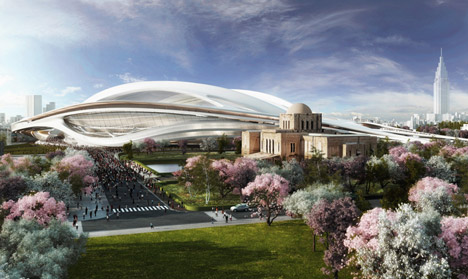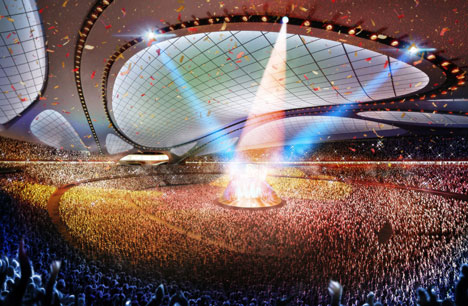Zaha Hadid modifies controversial Tokyo Olympic stadium design
News: Zaha Hadid Architects has confirmed it is adapting its design for the Tokyo 2020 Olympic stadium, following budget changes and ongoing criticism – including a 500-person street protest last weekend.
Zaha Hadid's competition-winning design for the new 80,000-seat stadium has been attacked by Japanese architects including Toyo Ito, Kengo Kuma, and Sou Fujimoto, who say it will be "too big" in relation to its surroundings.
The London-based firm says its new "refined" design will "optimise the investment and make the stadium even more efficient, user-focussed, adaptable and sustainable."
"All projects around the world go through this process of design evolution and refinement, and we are working closely with the client and our Japanese colleagues throughout the process," said a spokesman.
The Japan Sports Council – the government body that organised the competition – had already reduced the approved funds for the project from 300 billion yen (£1.8 billion) to 169 billion yen (£970 million) after sports minister Hakubun Shimomura described it as "too massive a budget".

Responding to this, Zaha Hadid Architects has adapted its proposal to use more cost-efficient and and visually lighter materials.
"Lightweight, tensile fabric between the stadium's structure significantly reduces the weight and materials of the roof, giving the stadium even greater flexibility as both an outdoor and indoor venue."
The firm declined to comment on whether the scale of the building will be cut back, stating only that the size is determined by the capacity required for hosting sporting events both during and after the games.
"Its scale is a direct correlation to the project brief's seating capacity of 80,000 to meet the client's requirements for flexibility and capacity, enabling the greatest future use by Japan's sporting, cultural, civic and community organisations. No construction works or redevelopment will be required for use after 2020," said the spokesman.
He also said the proposed central location – alongside Kenzo Tange's iconic 1964 Olympic stadium in Yoyogi Park – "further increases the stadium's accessibility for all Tokyo's residents".

Approximately 500 protestors took to the streets on Saturday to demonstrate against the plans, carrying signs that read "We want a compact and economical Olympics" and "Reverse the 2020 Tokyo Olympics".
Demonstration organiser Kazuhisa Oriyama told the Japan Times: "The organisers of the games need to reconsider their plans and make the public part of the decision-making process."
The stadium is set to host the opening and closing ceremonies for the 2020 games, as well as athletics, football and rugby events.
Zaha Hadid Architects previously designed the Aquatics Centre for the London Olympics in 2012.